Colombo Town Hall
| Town Hall | |
|---|---|

Colombo Town Hall
|
|
| General information | |
| Architectural style | Neoclassical |
| Town or city | Colombo |
| Country | Sri Lanka |
| Coordinates | 6°54′57.06″N 79°51′49.63″E / 6.9158500°N 79.8637861°ECoordinates: 6°54′57.06″N 79°51′49.63″E / 6.9158500°N 79.8637861°E |
| Construction started | 24 May 1924 |
| Completed | 9 August 1928 |
| Client | Colombo Municipal Council |
| Height | 51.3 m (168 ft) |
| Design and construction | |
| Architect | S. J. Edwards |
| Architecture firm | Ralph Booty & Co Ltd |
| Main contractor | A. A. Gammon and Co |
The Town Hall of Colombo is the headquarters of the Colombo Municipal Council and the office of the Mayor of Colombo. Built in front of the Viharamahadevi Park, Colombo, Sri Lanka, it is the meeting place for the elected municipal council.
In 1921 renowned Scottish town planner, Professor Patrick Geddes, recommended that the Council should construct a large central and dignified municipal building to house the council, a public reception hall, the mayor's office and a public library. The need for the Colombo Public Library was addressed by a philanthropic donation of a building by Dr. W. Arthur Silva in 1925. This building, Sirinivasa, is now the official residence of the mayor.
In 1922 the Colombo Municipal Council held an international architectural design competition and in November that year of the 32 plans submitted, the winning design was drawn by S. J. Edwards, of the architectural firm Ralph Booty & Co. In awarding the prize the Government Architect of the Ceylon Public Works Department, Austin Woodeson, wrote:
The foundation stone for the town hall was laid on 24 May 1924, by the Mayor of Colombo, Thomas Reid, CCS. The construction of the building was undertaken by A. A. Gammon & Co and four years later on 9 August 1928 it was formally opened by the Governor Sir Herbert Stanley KCMG. The cost of the new town hall was met largely by revenue generated by the Council, without taking out any loans from the central government and as a result, for years Municipal finances were depleted.
Edwards' design draws heavily from L'Enfant's neoclassical style Capitol Building in Washington, D. C.
...
Wikipedia
